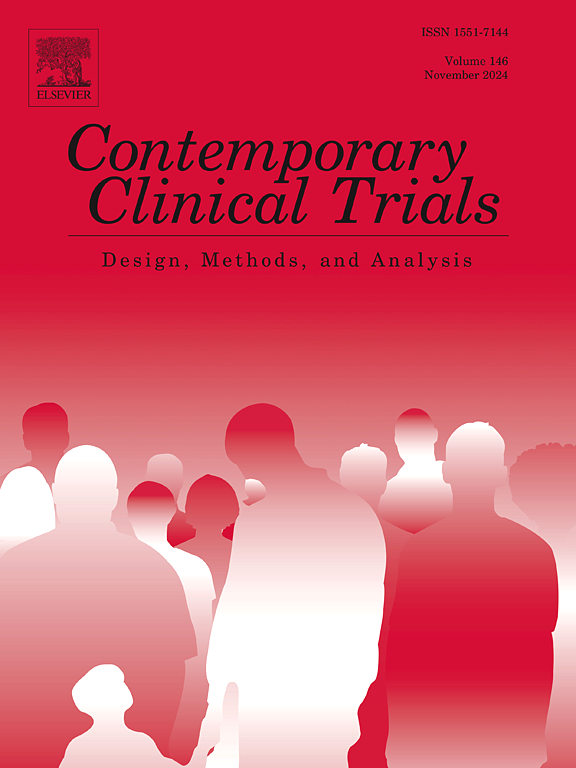Using a human-centered design framework and behavioral economic interventions to increase fruit and vegetable purchases in an online grocery store: Study design and methodologies
IF 2
3区 医学
Q3 MEDICINE, RESEARCH & EXPERIMENTAL
引用次数: 0
Abstract
Background
Diet-related chronic conditions are leading causes of death in the U.S. Healthier diets with fruits and vegetables can reduce the risk of developing these diseases. This study tests interventions to increase redemption of produce subsidies and purchases of fruits and vegetables using an online grocery delivery platform among people who have obesity and type 2 diabetes.
Design
Participants drawn from Penn Medicine primary care practices are given access to online grocery shopping and delivery. The intervention tests ways of increasing subsidy use for fruits and vegetables through a salience manipulation with loss-framed text messages, choice architecture on the grocery platform, or a combination of the two. A 10-person pre-pilot was trialed for two weeks. Learnings from qualitative interviews with the pre-pilot participants were used to refine the design prior to the launch of the 3-month randomized controlled trial (RCT) (projected n = 180).
Primary outcome
Total dollar expenditures of eligible fruits and vegetables across the 3 months of the study.
Secondary outcomes
1) mean percentage of the monthly subsidy used across 3 months; 2) cumulative percentage of expenditures spent on eligible fruits and vegetables (i.e., total spent on fruits and vegetables/total spent); 3) change in hemoglobin A1c from baseline; and 4) qualitative results including enrollment experience, experience using the study store, communication with the study team, and dietary effects of the study.
Discussion
The rationale, design, and protocol of this study are described. This study can provide insights on how food is medicine programs can be structured to improve engagement.
ClinicalTrials.gov Registration Number: NCT06283394
使用以人为中心的设计框架和行为经济干预来增加在线杂货店的水果和蔬菜购买量:研究设计和方法
在美国,与饮食有关的慢性疾病是导致死亡的主要原因。多吃水果和蔬菜的健康饮食可以降低患这些疾病的风险。本研究测试了在肥胖和2型糖尿病人群中使用在线杂货配送平台增加农产品补贴赎回和购买水果和蔬菜的干预措施。设计来自宾夕法尼亚大学医学院初级保健实践的参与者可以访问在线杂货购物和配送。该干预测试了增加水果和蔬菜补贴的方法,方法是通过对丢失框架的短信、杂货平台上的选择架构或两者结合的显著性操作来增加补贴。一名10人的预备飞行员进行了为期两周的试验。在启动为期3个月的随机对照试验(RCT)(预计n = 180)之前,利用与试点前参与者的定性访谈来完善设计。主要结果在研究的3个月里,符合条件的水果和蔬菜的总美元支出。次要结果:1)每月补助金在3个月内使用的平均百分比;2)在符合条件的水果和蔬菜上花费的累计百分比(即水果和蔬菜的总花费/总花费);3)血红蛋白A1c与基线相比的变化;4)定性结果,包括入组经验、使用研究库的经验、与研究团队的沟通、研究的饮食效果。本文描述了本研究的基本原理、设计和方案。这项研究可以提供关于如何构建食品医学项目以提高参与度的见解
本文章由计算机程序翻译,如有差异,请以英文原文为准。
求助全文
约1分钟内获得全文
求助全文
来源期刊
CiteScore
3.70
自引率
4.50%
发文量
281
审稿时长
44 days
期刊介绍:
Contemporary Clinical Trials is an international peer reviewed journal that publishes manuscripts pertaining to all aspects of clinical trials, including, but not limited to, design, conduct, analysis, regulation and ethics. Manuscripts submitted should appeal to a readership drawn from disciplines including medicine, biostatistics, epidemiology, computer science, management science, behavioural science, pharmaceutical science, and bioethics. Full-length papers and short communications not exceeding 1,500 words, as well as systemic reviews of clinical trials and methodologies will be published. Perspectives/commentaries on current issues and the impact of clinical trials on the practice of medicine and health policy are also welcome.

 求助内容:
求助内容: 应助结果提醒方式:
应助结果提醒方式:


